
Thinking about making some cash online?
Selling digital products is a cool way to do just that in 2024!
Whether you’re a wizard with design software, a guru at creating courses, or just someone with a knack for making things that others love, there’s a spot for you in the digital market.
And guess what?
You don’t need a warehouse for your products because everything’s online!
In this blog, you’ll discover:
- Cool digital products that are super popular online.
- Tips on setting the right price tag for what you’ve created.
- The best spots on the internet to sell your digital stuff.
So, here are the 21 best digital products to sell online to make money in 2024:
- Online courses
- Ebooks
- Digital templates and tools
- Memberships and paid communities
- Photography
- Stock videos
- Stock audio
- Podcasts
- Articles and blogs
- Guides and checklists
- Professional Services
- Newsletter subscriptions
- Webinars
- Craft patterns and downloadable prints
- Coaching and consulting sessions
- Social media paid subscriptions
- Fonts
- Website themes
- Software
- Web-based Applications (SaaS)
- Mobile apps
So, let’s explore these 21 most profitable digital products that you can start selling online today.
Plus, we’ll spill the beans on where to sell them to get your digital empire rolling.
1. Online Courses
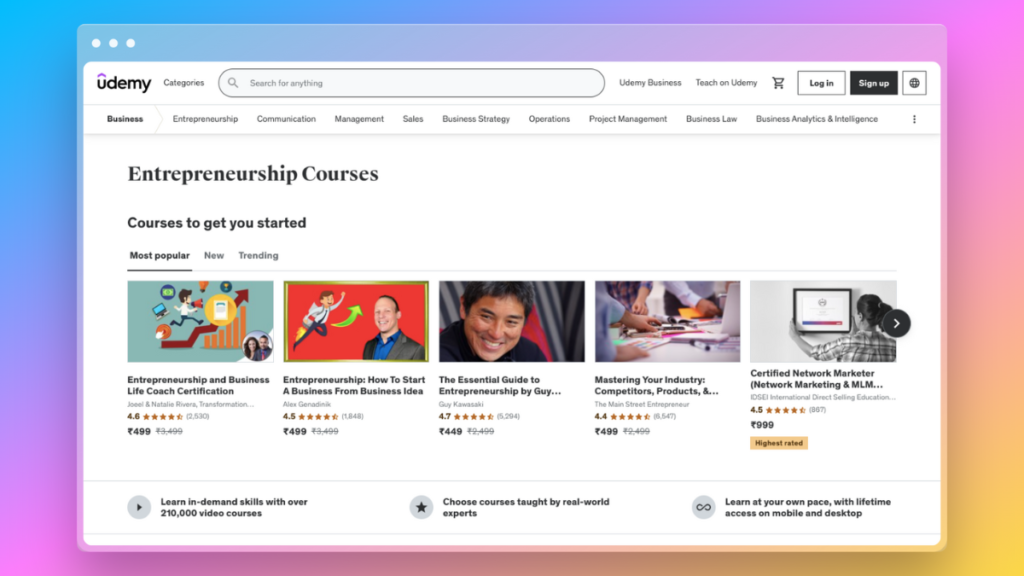
Ever thought you could share your favorite hobby or school subject with others and actually get paid for it?
With online courses, you can do exactly that. Whether you’re a master of digital art, a tech wizard, or a history buff, there’s a place for your knowledge in the online world.
The best part?
You create your course once, and it keeps earning for you while you sleep, game, or hang out with friends.
In today’s digital era, knowledge is more accessible than ever before, and your unique skills and passions have a place in this expansive online landscape.
Online courses have revolutionized the way we learn, allowing experts, enthusiasts, and educators alike to reach a global audience eager for new skills and insights.
Whether your strength lies in programming, painting, or even parkour, there’s an audience waiting to learn from you.
What makes online courses particularly appealing is their versatility and reach; you can teach anything from coding languages like Python to creative writing, yoga, or even how to play the ukulele.
Where to Sell Your Online Courses?
- Udemy: Think of Udemy as the mega-mall of online learning. Whatever you’re teaching, there’s someone here looking to learn it.
- Teachable: If you dream of setting up your own online school, Teachable gives you the keys to your kingdom. Customize your course site just the way you like it.
- Skillshare: Perfect for creatives and doers, Skillshare focuses on short, project-based classes. Great for sharing skills in art, design, photography, and more.
How Much Should You Charge For Online Courses?
Deciding on a price for your course might seem tricky, but it’s all about finding the sweet spot between what you need to earn and what students are willing to pay.
On average, courses range from:
- Quick Skills: $10 to $50 for short, focused lessons on specific skills or projects.
- Deep Dives: $100 to $500 for comprehensive courses that promise to turn beginners into experts.
For example, if you’re an expert at Photoshop, a short course on creating digital art could be priced at $30. But a complete guide to mastering Photoshop from scratch might be set at $200.
Remember, your course is more than just lessons; it’s a transformation for your students. Price it based on the value they’ll get by learning from you.
And don’t forget, as your course gains popularity, you can always adjust the price.
2. Ebooks

Have you ever dreamt of becoming an author, sharing stories, knowledge, or even guides on your favorite subjects?
Ebooks make this possible without the need for a big publishing house behind you.
Whether you’re crafting a fantasy world, offering insights on web design, or sharing recipes that make taste buds dance, there’s a reader for every ebook.
The beauty of ebooks is their simplicity and reach—you write once, and your words travel the globe in seconds.
With the rise of e-readers and smartphones, your potential audience has never been larger.
Where to Sell Your Ebooks?
- Amazon Kindle Direct Publishing (KDP): Amazon’s KDP lets you reach millions of readers worldwide, making it the go-to platform for budding authors.
- Apple Books: For those loyal to the iOS ecosystem, publishing on Apple Books offers access to a vast audience of Apple users.
- Smashwords: A popular choice for independent authors, Smashwords distributes your ebook to major retailers and libraries, expanding your reach.
How Much Should You Charge For Ebooks?
Setting the right price for your ebook is like choosing the perfect outfit for a first date; it needs to make the right impression and be comfortable for everyone involved.
You want your readers to see the value without hesitating on the click to buy.
Ebooks typically range in price from:
- Short Reads: $0.99 to $2.99 for quick guides, short stories, or novellas that offer a taste of your style or expertise.
- Full-Length Works: $2.99 to $9.99 for novels, comprehensive guides, or detailed non-fiction that promises hours of engagement or learning.
For instance, a concise ebook on beginner’s photography tips might be priced at $2.99, attracting hobbyists looking for a quick start. Meanwhile, an in-depth guide covering advanced photography techniques could be set at $8.99, appealing to more serious enthusiasts willing to invest in their passion.
Remember, your ebook does more than just share knowledge or stories; it connects you with readers worldwide.
Price it not just for the sale, but for the value it adds to every reader’s life.
As your reputation grows and your catalog expands, revisiting your pricing strategy will help you maximize both your reach and earnings.
3. Digital Templates and Tools
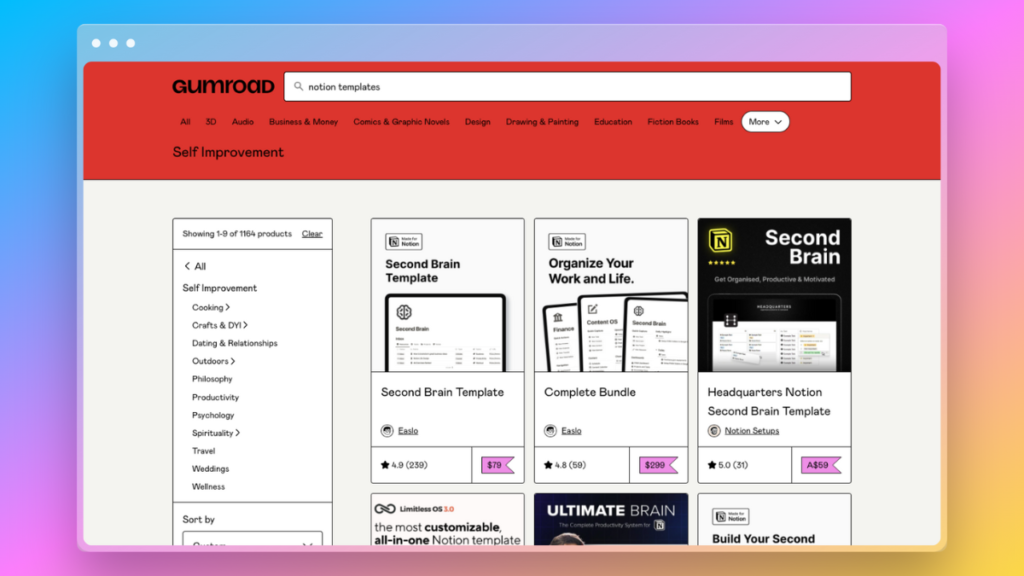
Ever noticed how everyone wants to achieve professional results but not everyone has the skills or time to start from scratch?
That’s where digital templates and tools come in.
Whether it’s a sleek resume layout, a budget planner, or social media graphics, your knack for creating useful templates can turn into a lucrative endeavor.
The digital world thrives on efficiency and aesthetics, and by providing ready-made solutions, you’re essentially offering a shortcut to both.
Digital templates and tools cater to a broad audience, from entrepreneurs looking to brand their startups, to students wanting to impress on their next assignment.
The key is identifying a need and filling it with creative and practical solutions.
Where to Sell Your Digital Templates and Tools?
- Etsy: Known for handmade and vintage items, Etsy is also a fantastic place for digital products like planners, art prints, and graphic designs.
- Creative Market: Creative Market is a platform for designers and creatives to sell their digital assets, including fonts, templates, and more, to a global audience.
- Gumroad: Ideal for a wide range of the most profitable digital products, Gumroad simplifies the selling process and is perfect for independent creators.
How Much Should You Charge For Digital Templates and Tools?
The pricing of digital templates and tools can be as varied as the products themselves.
Consider these factors:
- Simple Templates: $2 to $10 for items like basic planners or simple graphic design templates. These are quick to make and offer a straightforward solution for your customers.
- Complex Tools: $10 to $50 (or more) for more sophisticated or niche-specific templates, such as comprehensive business branding kits or advanced financial trackers.
For example, a minimalist yet elegant resume template might be priced at $5, appealing to job seekers looking to stand out without breaking the bank. On the other hand, a complete branding package for small businesses could go for $45, offering a full suite of designs that create a cohesive brand identity.
When pricing your digital templates and tools, consider the time you invested in creating them and the potential time and effort they save for your customers.
It’s about striking a balance between fair compensation for your creativity and providing real value to your customers.
As with other digital products, flexibility in pricing and paying attention to customer feedback can guide you to the best strategy over time.
4. Memberships and Paid Communities

Imagine creating a space where your biggest fans or fellow enthusiasts can gather, share, and learn from each other and you.
That’s the power of memberships and paid communities.
Whether it’s a club for aspiring writers, a network for drone racing aficionados, or a supportive group for indie game developers, creating a paid community offers both a sense of belonging and a steady income stream.
It’s about turning your passion into a platform where others can connect, grow, and celebrate shared interests.
Memberships and paid communities thrive on exclusive content, direct access to experts (you!), and the camaraderie of like-minded individuals.
It’s not just about the content you provide but the connections and experiences you facilitate.
Where to Sell Your Memberships and Paid Community?
- Patreon: Ideal for creators of all kinds, Patreon lets you build subscription-based communities where members get exclusive access to your work and insights.
- Memberful: Memberful is a great tool for integrating memberships directly into your existing website, offering seamless access to exclusive content, forums, and more.
- Discord: While not a traditional membership platform, Discord allows the creation of private servers where you can offer paid access to communities centered around specific topics or interests.
How Much Should You Charge For Memberships and Paid Community?
When it comes to setting membership fees, consider the value of the community experience and the exclusivity of the content you’re offering:
- Basic Access: $5 to $10 per month for entry-level memberships that might include access to a private forum, regular newsletters, and some exclusive content.
- Premium Experience: $10 to $30 (or more) per month for memberships that offer more in-depth interaction, such as live Q&A sessions, personalized advice, workshops, and detailed resources or courses.
For instance, a monthly subscription for a fitness community might be priced at $15, offering weekly workout plans, nutritional advice, and live sessions with fitness experts. A premium writing group could charge $25 per month, providing critique sessions, writing prompts, guest author webinars, and opportunities for publication.
When determining the price, consider the uniqueness of the experience, the level of access to you or other experts, and the intensity of the engagement and support provided.
Start with a price that reflects the value members receive while remaining accessible to your target audience.
As your community grows and evolves, there’s always room to adjust your pricing model based on the feedback and the added value you’re able to provide over time.
5. Photography

Have you ever snapped a photo that made your friends go “Wow”?
Or maybe you have a collection of images from your travels, nature walks, or city explorations that are just sitting on your hard drive.
Your photography isn’t just art; it’s a potential source of income.
Online, there’s a huge demand for original, high-quality images for websites, marketing materials, and social media.
From breathtaking landscapes to candid street photography, each picture you take is a chance to earn and share your unique perspective with the world.
Photography sells not just because of the image itself but because of the story it tells and the emotions it evokes.
It’s about seeing the world through your lens and capturing moments that others might miss.
Where to Sell Your Photography?
- Shutterstock: A giant in the stock photography world, Shutterstock welcomes photographers to sell their images to a global audience.
- Adobe Stock: Integrated with Adobe’s creative suite, selling your photos at Adobe Stock can put them right in front of graphic designers and businesses.
- Etsy: Known for handmade goods, Etsy is also a great place for photographers to sell their work as prints or digital downloads.
How Much Should You Charge For Photography?
Photography pricing can vary widely based on the type of photo, usage rights, and exclusivity:
- Stock Photos: $0.25 to $100 per download, depending on the platform’s payment structure and the license type. Stock photos are usually less about making a big sale and more about volume.
- Prints and Digital Downloads: $10 to $500, significantly influenced by the size of the print, the reputation of the photographer, and the uniqueness of the image.
For instance, a unique, high-resolution photo of a rare wildlife moment might sell for $100 as a digital download for personal use. Meanwhile, limited edition prints signed by you could go for $200 or more, appealing to art collectors and enthusiasts.
When pricing your photography, consider the market demand for the subject matter, your own level of expertise, and the uniqueness of your work.
It’s also a good idea to offer a range of options, from more affordable stock photos to premium prints, catering to different customer needs and budgets.
6. Stock Videos
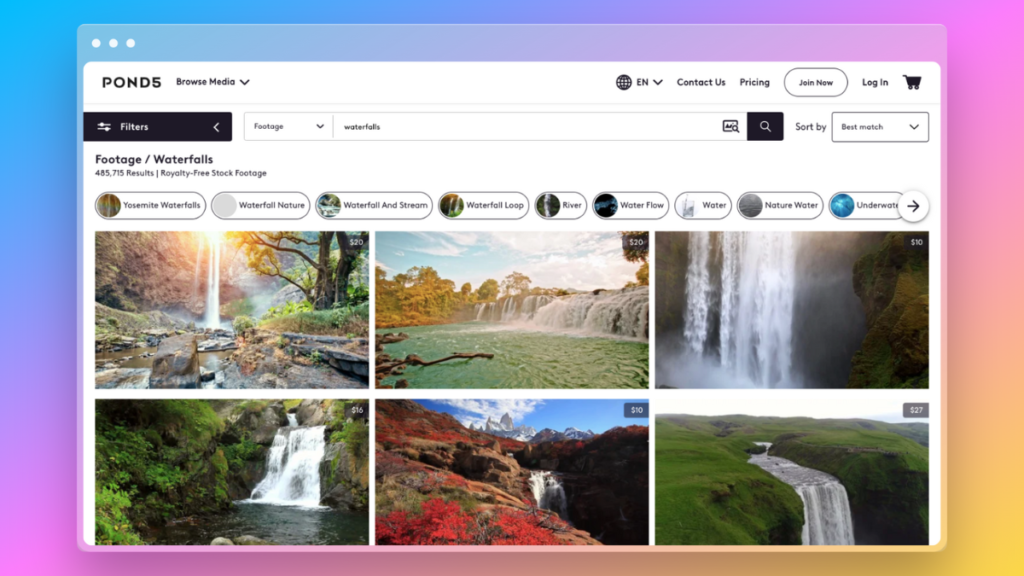
In a world where video content is king, your knack for capturing engaging or beautiful footage can turn into a lucrative venture.
Stock videos range from breathtaking aerial shots to everyday scenes captured in high definition.
Content creators, marketers, and businesses are always on the lookout for high-quality video clips to enhance their projects, making this an excellent time to dive into the world of stock videography.
Your videos can help bring websites, advertisements, and digital content to life.
It’s about providing visual storytellers with the building blocks they need to convey their messages compellingly and attractively.
Where to Sell Your Stock Videos?
- Pond5: A platform that prides itself on its diverse collection of stock videos, Pond5 is a favorite among filmmakers and video content creators.
- Shutterstock Video: Similar to its photography counterpart, Shutterstock also offers a vast audience for your stock videos, catering to a wide range of needs.
- Adobe Stock: Given Adobe’s integration with creative software, selling your stock videos here can place them directly in the workflow of professional video editors and designers.
How Much Should You Charge For Stock Videos?
The pricing for stock videos can significantly differ based on the clip’s length, quality, uniqueness, and usage rights:
- Short Clips (up to 30 seconds): $20 to $200 per download, ideal for quick scenes or backgrounds.
- Longer, More Detailed Footage: $200 to $500 or more for clips that offer extensive, high-quality content, such as elaborate time-lapses or detailed nature scenes.
Imagine capturing a stunning time-lapse of a cityscape from day to night; such a clip could be priced towards the higher end due to its visual appeal and the effort required to create it. On the other hand, a simple but useful clip of pedestrian foot traffic might be priced more modestly, yet still appeal to a broad audience.
When determining prices for your stock video content, consider the production value, including the equipment used, the time invested, and the clip’s potential applications.
Offering a range of content—from simple shots to complex scenes—can help cater to various customers and budget ranges, increasing your earning potential.
7. Stock Audio
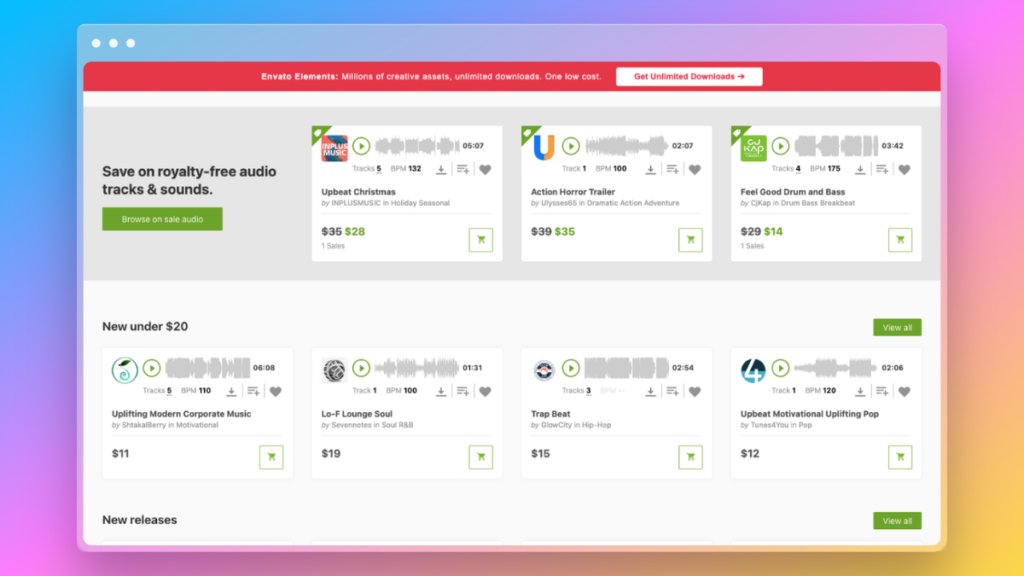
In the digital age, the soundtrack to content creation isn’t just background noise; it’s a vital piece of the storytelling puzzle.
From podcast intros to background music for YouTube videos, the demand for high-quality stock audio is booming.
If you have a talent for creating catchy tunes, atmospheric soundscapes, or even crisp sound effects, there’s a market for your audio creations. Your work can elevate projects, adding depth and emotion that visuals alone cannot convey.
Stock audio provides a symphony of opportunities, allowing creators to share their musical talents or sound engineering skills with a global audience.
It’s about crafting the sounds that become the unseen characters in videos, games, and digital media.
Where to Sell Your Stock Audio?
- AudioJungle: Part of the Envato Market, AudioJungle offers a wide audience for your music and sound effects, catering to creators looking for everything from jingles to cinematic scores.
- Pond5: Known for its stock videos, Pond5 also has a robust section for stock audio, appealing to filmmakers and content creators seeking high-quality soundtracks.
- SoundCloud: While primarily a platform for artists to share their music, SoundCloud can also be a way to market your stock audio creations directly to your followers.
How Much Should You Charge For Stock Audio?
The price tags for stock audio can vary widely based on the complexity, length, and intended use of the audio clip:
- Sound Effects: $1 to $5 for simple effects, perfect for adding realism to videos or games.
- Background Tracks: $15 to $50 for longer pieces that set the mood or theme for content, depending on the track’s uniqueness and versatility.
For example, a short sound effect like a doorbell ringing might be priced at $2, offering a simple yet necessary element for content creators. Meanwhile, a fully produced instrumental track that can serve as the backdrop for a variety of content might be set at $40, reflecting the broader application and creative effort involved.
When pricing your stock audio, consider the value it provides to the end-user.
High-quality, versatile tracks that can be used across multiple projects may warrant a higher price point.
Additionally, offering bundles of related sounds or tracks can provide more value to your customers and encourage larger purchases.
8. Podcasts

Podcasts have exploded in popularity, becoming the go-to source for entertainment, education, and inspiration for millions worldwide.
If you have a knack for storytelling, a passion for sharing knowledge, or just love engaging in meaningful conversations, launching a podcast can be your digital microphone to the world.
From true crime to technology, health, and personal development, there’s a niche for every interest. What makes podcasts especially appealing is their ability to connect with listeners on a personal level, creating communities around shared passions and curiosities.
Producing a podcast involves more than just hitting record; it’s about crafting engaging content, honing your audio editing skills, and consistently delivering value to your listeners.
The intimacy of audio content allows for a unique connection with your audience, making it a powerful medium for sharing your voice and ideas.
Where to Sell Your Podcasts?
- Anchor: Anchor is a user-friendly platform that not only hosts your podcast for free but also distributes it to all the major podcast platforms, including Spotify and Apple Podcasts.
- Libsyn: Libsyn is one of the oldest and most respected podcast hosting services, offering plans that cater to podcasts of all sizes and ambitions.
- Podbean: Podbean offers easy podcast publishing and monetization services, with a wide range of tools to help podcasters reach their audience effectively.
How Much Should You Charge For Podcast?
Monetizing a podcast can take several forms, from sponsorships and advertising to listener support and premium content:
- Sponsorships: Partner with brands that align with your podcast’s theme and audience. Rates can vary widely but are often based on your listener numbers, with a common benchmark being $18 to $25 per 1,000 listeners for a mid-roll ad.
- Listener Support: Platforms like Patreon allow your most dedicated fans to support your podcast financially, in exchange for exclusive content or perks.
- Premium Content: Offer additional, exclusive episodes or content for a fee. This could range from $5 to $10 per month, providing a steady income stream while rewarding your most loyal listeners.
Imagine diving deep into your favorite topic, sharing insights, and stories, then connecting with listeners who share your passion. A podcast on emerging tech trends, for example, could attract tech enthusiasts and professionals alike, providing a platform to explore the latest innovations and ideas.
When considering monetization, focus on building your audience and engaging with them authentically. As your listener base grows, so too will your opportunities for monetization.
The key is to start with content that resonates, maintain a consistent posting schedule, and engage with your community. The financial rewards will follow as your podcast’s reach expands.
9. Articles and Blogs

In the vast landscape of the internet, content is king. Articles and blogs serve as the lifeblood of digital communication, offering endless opportunities for writers to share their expertise, insights, and stories.
Whether you’re passionate about sustainable living, the intricacies of blockchain technology, or the latest fashion trends, your written word has the power to inform, inspire, and influence readers across the globe.
What’s more, your articles and blogs can become a steady source of income, transforming your love for writing into a profitable venture.
The beauty of writing articles and blogs lies in the diversity of topics you can explore and the various formats you can experiment with, from in-depth guides and how-to articles to personal narratives and opinion pieces.
It’s about connecting with your audience, sparking conversations, and building a community around shared interests.
Where to Sell Your Articles and Blogs?
- Medium: A platform that bridges the gap between blogging and professional publishing, Medium allows writers to reach an existing audience interested in a wide range of topics.
- WordPress: With its flexibility and power, WordPress is perfect for those looking to build their own blog or article repository from the ground up.
- Substack: Revolutionizing the email newsletter, Substack provides a platform for writers to publish directly to their subscribers’ inboxes, enabling monetization through paid subscriptions.
How Much Should You Charge For Articles and Blogs?
Turning your articles and blogs into a source of income can be achieved through several avenues:
- Ad Revenue: Platforms like AdSense allow you to earn money from ads displayed on your blog or website. Earnings can vary widely based on traffic, with some sites making a few dollars to hundreds or thousands per month.
- Sponsored Content: Partner with brands to create content that promotes their products or services. Rates for sponsored posts can range from $50 to $500 or more, depending on your site’s reach and niche.
- Subscription Models: Platforms like Substack make it easy to offer premium content to subscribers for a monthly fee, providing a direct income stream from your most dedicated readers.
Imagine sharing your culinary adventures or personal finance tips and not only reaching people who share your interests but also creating a sustainable income stream. For instance, a detailed blog post on budget travel hacks could attract sponsorship from travel agencies or gear companies, while an insightful article series on mental health could be offered as premium content to subscribers.
When it comes to monetizing your writing, the key is to provide consistent, high-quality content that resonates with your audience.
Building a loyal readership takes time, but it opens doors to various monetization strategies that reward your dedication to your craft.
10. Guides and Checklists

In a world brimming with quests for knowledge and efficiency, guides and checklists stand as beacons, directing readers toward achieving their goals with precision and clarity.
Whether it’s mastering a new skill, organizing life’s complexities, or embarking on adventurous travels, your expertise can pave the way for others.
Crafting detailed guides and practical checklists transforms your knowledge and experiences into valuable tools that others can use to navigate their own journeys.
The appeal of guides and checklists lies in their ability to break down daunting tasks into manageable steps, offering a clear path to accomplishment.
They encapsulate wisdom in a digestible format, making them indispensable resources in both personal and professional realms.
Where to Sell Your Guides and Checklists?
- Gumroad: A favorite for creators looking to sell the most profitable digital products directly to their audience, Gumroad simplifies the process of selling guides and checklists.
- Etsy: Not just for crafts, Etsy is a great platform for selling beautifully designed PDF guides and checklists on a wide range of topics.
- Your Own Website: Hosting your guides and checklists on your personal website or blog can not only boost your digital presence but also provide a direct channel to your audience.
How Much Should You Charge For Guides and Checklists?
Determining the value of your guides and checklists involves assessing the depth of information, the potential impact on the user, and the uniqueness of your insights:
- Short Checklists: $2 to $5 for simple, topic-specific checklists that offer quick wins or streamline everyday tasks.
- Comprehensive Guides: $10 to $50 for in-depth guides that cover topics extensively, providing significant value and actionable insights.
For instance, a compact checklist for a daily meditation routine might be priced at $3, offering a straightforward tool for beginners. Conversely, an elaborate guide to starting a freelance business could be valued at $30, reflecting the detailed advice, strategies, and resources compiled from your experience.
When pricing your products, consider the transformation or efficiency your work offers to the buyer.
Your guides and checklists are more than just information; they’re catalysts for change, growth, and achievement.
Starting with a price that reflects the value provided, while remaining accessible, can help you build a loyal customer base that values your expertise.
11. Professional Services
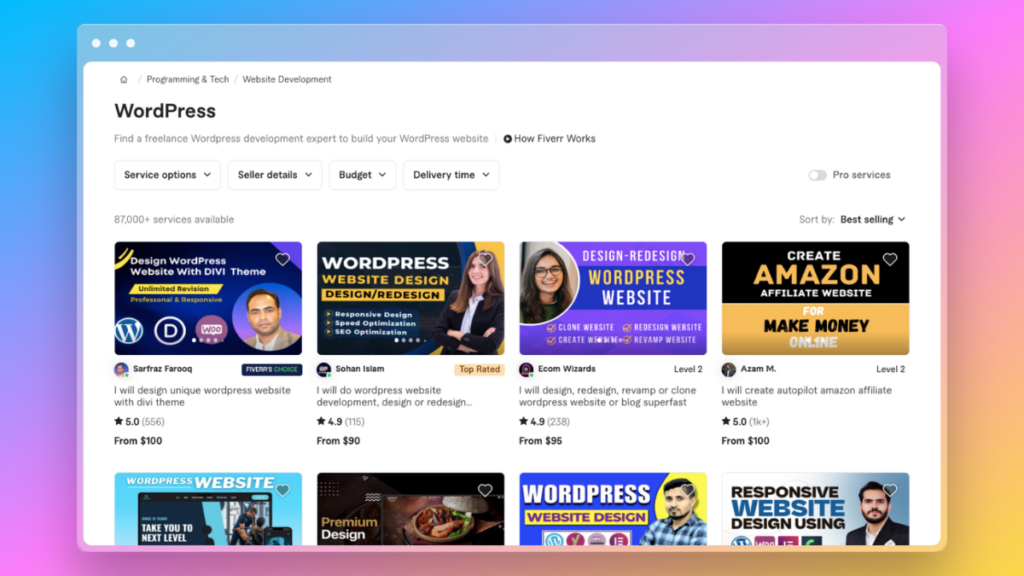
In the digital marketplace, your expertise is a highly valuable commodity.
Whether you’re a wizard with graphic design, a marketing maestro, or a coding champion, offering your professional services online can connect you with clients from around the globe.
Unlike traditional digital products, professional services involve trading your time and skills for compensation, providing tailored solutions to meet specific client needs.
This personalized approach not only brings your expertise directly to those who need it but also allows you to command higher prices based on your experience and the complexity of the work involved.
The demand for professional services online has surged, with businesses and individuals seeking experts who can help them achieve their goals.
From website development to digital marketing strategies and custom graphic design, your skills can make a significant impact on your client’s success.
Where to Sell Your Professional Services?
- Upwork: A leading platform for freelancers of all kinds, Upwork connects you with clients looking for your specific expertise.
- Fiverr: With its easy-to-use interface, Fiverr offers a marketplace for creative and professional services, allowing you to package your skills into offers.
- LinkedIn: Leveraging your professional network, LinkedIn can be a powerful tool for showcasing your services and connecting with potential clients.
How Much Should You Charge For Professional Services?
When it comes to pricing your professional services, consider the following:
- Hourly Rates: $20 to $150 or more, depending on your skill level and the demand for your expertise. For example, a freelance graphic designer might charge $50 per hour, while a specialized software developer could charge $100 per hour or more.
- Project-Based Fees: Determined by the scope of the project, these can range widely. A comprehensive digital marketing campaign might be priced at $2,000 while designing a simple website could start at $500.
It’s essential to assess the value you bring to your clients, considering the outcomes they can expect from your work.
Transparently communicating this value can justify your rates and help build trust with your clients.
When setting your prices, also factor in the time investment, the complexity of the projects you take on, and the tangible benefits your clients will receive.
Offering package deals or tiered pricing for different levels of service can attract a wider range of clients, providing options for various budgets and needs.
12. Newsletter Subscriptions

Turning your insights, stories, or curated content into a newsletter subscription service can create a direct line to your audience’s inboxes, building a community of readers who value your perspective.
Whether you’re dissecting the week’s news, sharing industry trends, or offering life advice, a newsletter can transform casual readers into a dedicated following willing to pay for premium content.
Newsletters stand out for their ability to foster a personal connection with subscribers, offering exclusive insights, behind-the-scenes looks, or early access to your content.
This format allows for a unique blend of personal storytelling and professional analysis, making it a versatile tool for creators.
Where to Sell Your Newsletter Subscriptions?
- Substack: Pioneering the paid newsletter model, Substack offers an intuitive platform for writing, publishing, and monetizing your newsletter.
- Mailchimp: While traditionally used for email marketing, Mailchimp also supports paid newsletter services, giving you advanced tools for managing your subscriber list.
- ConvertKit: Designed for creators, ConvertKit facilitates building and monetizing an audience, with robust features for managing subscriptions and content.
How Much Should You Charge For Newsletter Subscriptions?
Pricing a newsletter subscription requires balancing the content’s value with accessibility:
- Basic Tier: $5 to $10 per month for newsletters offering regular insights, updates, or exclusive content, making it an affordable option for most readers.
- Premium Tier: $10 to $30 per month for in-depth analysis, comprehensive guides, or access to a community forum, tailored for subscribers seeking more from your expertise.
Imagine offering a weekly digest of tech innovations for $5 per month, appealing to tech enthusiasts eager for the latest news without the overwhelm. Or, a detailed monthly report on market trends for $20 per month, targeting professionals seeking actionable insights.
When setting your subscription prices, consider the frequency and depth of your content, as well as the unique benefits subscribers will receive.
Offering tiered pricing can cater to different audience segments, enhancing your newsletter’s appeal to a broader range of readers.
13. Webinars

Webinars have emerged as a powerful medium for sharing knowledge, connecting with audiences, and offering in-depth training or discussions on a wide array of topics.
Whether you’re an expert in digital marketing, a seasoned entrepreneur, or a wellness coach, webinars allow you to broadcast your expertise to an engaged audience from anywhere in the world.
The interactive nature of webinars—complete with Q&A sessions, live polls, and real-time feedback—enriches the learning experience, making them a popular choice for those looking to deepen their understanding of a subject.
The appeal of webinars lies in their ability to offer immediate value through live interaction, making them an excellent tool for building trust and establishing authority in your niche.
Where to Sell Your Webinars?
- Zoom: A familiar tool for many, Zoom’s webinar feature is robust and widely used, offering a reliable way to connect with your audience.
- GoToWebinar: Designed specifically for webinars, GoToWebinar is a popular choice for professionals looking for comprehensive webinar hosting features.
- WebinarJam: Known for its marketing tools and engagement features, WebinarJam can help maximize your webinar’s impact.
How Much Should You Charge For Webinars?
The pricing strategy for your webinars can vary based on the content’s exclusivity, the level of interaction offered, and the length of the session:
- One-Time Sessions: $20 to $100 for a single webinar, depending on the topic’s complexity and the speaker’s expertise. These can range from introductory overviews to specialized deep dives.
- Series or Course: $100 to $500 for a series of webinars that cover a topic comprehensively, providing value through a structured learning path.
For example, a one-time webinar on basic SEO practices might be priced at $30, offering a solid foundation for beginners. In contrast, an in-depth series on advanced SEO techniques, including case studies and live site audits, could be priced at $300, reflecting the comprehensive nature and interactive elements of the course.
When deciding on your pricing, consider the transformation or outcome you promise your attendees.
The more tangible the takeaways, the higher the perceived value of your webinar.
Additionally, offering early bird pricing or discounts to subscribers can increase sign-ups and foster a sense of community among your audience.
14. Craft Patterns and Downloadable Prints

The digital realm offers an expansive canvas for artists and crafters to share their creations with enthusiasts worldwide.
Craft patterns and downloadable prints represent a unique intersection of art and convenience, allowing customers to access your designs instantly.
Whether you specialize in knitting patterns, digital illustrations, or printable planners, your creations can transform someone’s space or hobby into something extraordinary.
These digital products cater to a diverse audience, from DIY enthusiasts and home decorators to fellow artists looking for inspiration.
The beauty lies in providing a personal touch that can be replicated in the physical world, bridging the gap between digital artistry and tangible creations.
Where to Sell Your Craft Patterns and Downloadable Prints?
- Etsy: A haven for all things handmade and digital, Etsy is the go-to platform. Craft patterns and downloadable prints are the best digital products to sell on Etsy, offering a vast audience actively seeking unique, creative content.
- Creative Market: Tailored for graphic designers and digital artists, Creative Market is an excellent place to sell your digital prints, website themes, and more.
- Ravelry: Specifically for knitting and crochet patterns, Ravelry connects you with a passionate community of crafters eager for their next project.
How Much Should You Charge For Craft Patterns and Downloadable Prints?
Craft patterns and downloadable prints can vary significantly in price, influenced by the complexity of the design, the potential use, and your reputation as a creator:
- Simple Patterns and Prints: $2 to $10 for straightforward designs that offer quick projects or simple decorations.
- Elaborate Designs: $10 to $30 for more complex or detailed patterns that provide substantial value or require more skill to create.
For instance, a basic cross-stitch pattern might be priced at $5, appealing to beginners looking for an easy project. Conversely, a comprehensive bundle of printable home organization templates could be set at $20, offering a complete solution for buyers looking to declutter their space.
When setting prices for your digital designs, consider the effort and creativity that went into each piece.
Reflect on the joy and satisfaction customers will derive from bringing your designs to life in their own projects or homes.
Offering a range of designs—from simple to complex—can cater to various skill levels and interests, broadening your market appeal.
15. Coaching and Consulting Sessions

Ever realized that your advice could be the key to someone else’s success?
Imagine turning your insights and expertise into a thriving online service. In the world of digital growth, coaching, and consulting sessions stand out as personalized pathways to achievement.
Whether you’re guiding someone through their career, helping businesses overcome hurdles, or supporting individuals in personal development, your knowledge has immense value.
It’s about more than sharing advice; it’s about empowering others to reach their full potential.
The magic of coaching and consulting lies in the personalized connection and tailored strategies you offer.
It’s the difference between reading a self-help book and having the author walk beside you, applying their wisdom to your unique situation.
Where to Sell Your Coaching and Consulting Sessions?
- Zoom: Break down geographical barriers and connect with clients worldwide with face-to-face sessions that feel as personal as a coffee shop meeting.
- Calendly: Let clients book sessions with ease, integrating seamlessly with your calendar and ensuring you’re both prepared for transformational meetings using Calendly.
- Teachable: Not just for courses, Teachable allows you to offer consulting services, manage clients, and process payments all in one place.
How Much Should You Charge For Coaching and Consulting Sessions?
When it comes to pricing your expertise, it’s about striking a balance between the value you provide and what your clients are willing and able to pay:
- Hourly Consultations: $50 to $300, reflecting the depth of your expertise and the nature of the consultation. For example, a session on digital marketing strategies might be priced at $150, offering actionable advice that can significantly boost a business’s online presence.
- Package Deals: $500 to $2,000 for bundles that might include a series of sessions, email support, and personalized resources. This could be ideal for comprehensive career coaching or extensive business development projects.
Imagine the impact of your advice on someone’s startup journey or the clarity you could bring to an individual’s career decisions. Your sessions offer more than just information; they provide a roadmap to success tailored to each client’s needs.
As you set your prices, remember the transformation you’re promising.
Your sessions are an investment in your client’s future, and your pricing should reflect the significant, lasting change they can expect to achieve.
16. Social Media Paid Subscriptions

Have you ever thought your social media content could be worth more than likes and shares?
With the advent of paid subscriptions on platforms like Instagram, Twitter, and YouTube, creators now have the opportunity to turn their followers into a supportive community that contributes directly to their creative journey.
Whether you’re a fitness guru sharing exclusive workout routines, a culinary wizard with secret recipes, or a DIY master teaching crafty skills, social media paid subscriptions allow you to reward your most loyal followers with premium content.
This digital product transforms your social media presence into a subscription-based model, where followers pay a monthly fee for access to exclusive content, live sessions, and one-on-one interactions.
It’s about deepening the connection with your audience and offering them value that goes beyond what’s available for free.
Where to Sell Your Social Media Paid Subscriptions?
- Patreon: Connect with your fans by offering them exclusive content, community access, and perks in exchange for their support.
- YouTube Memberships: If video is your medium of choice, YouTube Memberships lets your viewers join your channel with monthly payments for exclusive badges, emojis, and content.
- Substack: Perfect for writers, Substack allows you to monetize your newsletters and written content, creating a subscriber-based community.
How Much Should You Charge For Social Media Paid Subscriptions?
Pricing your social media subscriptions involves understanding the unique value you provide:
- Entry-Level Access: $1 to $5 per month for basic perks such as exclusive posts or early access to your content. This tier is great for a broad audience looking to support you and get a little more in return.
- Premium Content: $5 to $20 per month for more in-depth engagement, including personalized advice, exclusive videos, or members-only live streams.
Consider a travel influencer offering monthly destination guides, behind-the-scenes travel planning tips, and live Q&A sessions for $10 per month. Or a home organization expert providing weekly decluttering challenges, personalized consulting slots, and downloadable organization checklists for $15 per month.
Your social media paid subscriptions should reflect the effort you put into creating exclusive content and the level of interaction you offer.
Think about what your followers value most about your content and how you can enhance their experience through a subscription model.
17. Fonts

Imagine every word you write dressed in a style that speaks volumes, from sleek and modern to whimsical and enchanting.
That’s the power of fonts.
In the vast expanse of digital content, the right font can elevate a message, brand, or project from ordinary to extraordinary.
If you have a flair for typography and design, creating and selling your own fonts can be a lucrative way to share your artistic talents with the world.
Every curve, line, and letter you design contributes to a visual language that can communicate mood, tone, and personality.
Fonts are essential tools for designers, marketers, and businesses looking to stand out in a crowded digital space.
Your creations can become the voice of brands, the style of websites, or the charm of wedding invitations.
Where to Sell Your Fonts?
- MyFonts: One of the largest font marketplaces, MyFonts offers designers a platform to sell their work to a vast audience of typography enthusiasts and professionals.
- Creative Market: Catering to a broad range of digital design products, Creative Market is an excellent place for selling fonts alongside other creative assets.
- FontSpring: A straightforward platform for font designers, FontSpring simplifies the process of selling fonts, offering fair commission rates and exposure to a dedicated community.
How Much Should You Charge For Fonts?
The pricing of fonts can range widely based on their uniqueness, complexity, and the breadth of the font family:
- Single Fonts: $10 to $100, for individual typefaces that offer specific styles or functionalities. A simple, clean sans-serif font might be on the lower end, while a font with extensive weights and styles could command a higher price.
- Font Families: $100 to $500 or more, for collections of fonts that provide versatility through multiple weights, italics, and features. A comprehensive font family, meticulously designed for various applications, can offer immense value to buyers.
For example, a hand-drawn display font that captures the essence of adventure might be priced at $30, appealing to designers creating outdoor-related branding. In contrast, a versatile serif font family designed for editorial use could be priced at $300, reflecting its wide applicability and the depth of design work involved.
When pricing your fonts, consider the time invested in their creation, the range of applications they can serve, and the value they add to design projects.
Offering a selection of individual typefaces and more extensive font families can cater to different customer needs, from quick style updates to comprehensive branding overhauls.
18. Website Themes
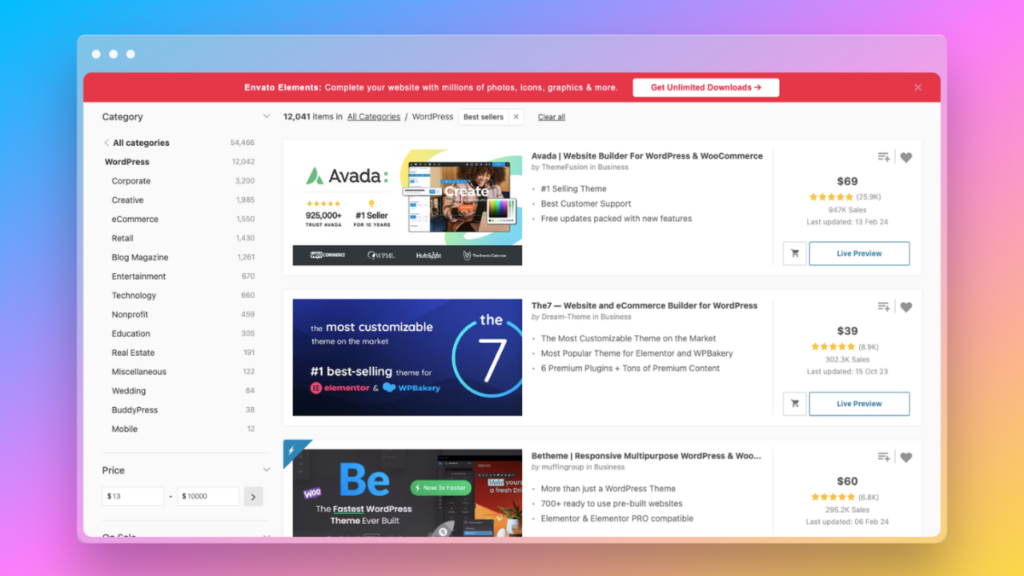
In the digital age, a website is more than just an online presence; it’s a reflection of one’s identity, brand, or mission.
As a designer, your ability to craft website themes can transform the way content is experienced online.
From minimalist blogs to vibrant e-commerce platforms, the themes you create set the stage for stories, products, and ideas to shine. This is where your keen eye for design meets the practical needs of website functionality, offering a blend of beauty and usability that enhances user engagement.
Creating website themes involves a deep understanding of user experience, aesthetic trends, and the technical foundations that make a website work seamlessly.
Your themes can empower others to build their dream online spaces, whether for personal projects, businesses, or creative freelance portfolios.
Where to Sell Your Website Themes?
- ThemeForest: Part of the Envato Market, ThemeForest is one of the most popular places to sell website themes, offering a vast audience of buyers looking for high-quality designs.
- TemplateMonster: TemplateMonster is a longstanding marketplace that connects talented designers with businesses and individuals in search of the perfect website template.
- Creative Market: Known for its designer-friendly approach, Creative Market is an excellent platform for selling website themes alongside other creative assets.
How Much Should You Charge For Website Themes?
Determining the price of your website themes involves assessing their complexity, versatility, and market demand:
- Basic Themes: $30 to $60, for simple yet elegant themes that offer straightforward customization options, suitable for personal blogs or small business websites.
- Premium Themes: $60 to $200 or more, for themes that come with a wide range of features, customization options, and dedicated support. These themes cater to more complex websites with specific needs, such as e-commerce platforms or large-scale content sites.
For example, a chic and minimalistic theme designed for lifestyle bloggers might be priced at $50, appealing to those looking for style and simplicity. On the other hand, a feature-rich e-commerce theme, complete with various shop layouts and product display options, could be set at $150, reflecting its added value to online retailers.
When pricing your themes, consider the design and development time, the level of support you plan to offer, and the potential return on investment for your customers.
Offering a range of themes, from basic to premium, can accommodate different budgets and website needs, broadening your reach in the market.
19. Software
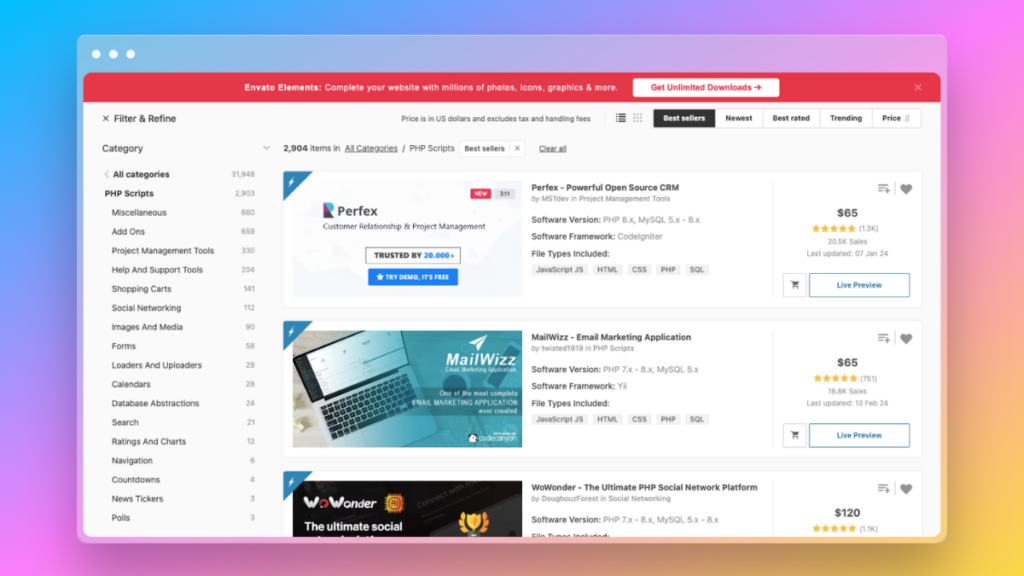
In an era where technology underpins almost every aspect of life, developing and selling your own software can be a game-changer.
Whether it’s a mobile app that simplifies daily tasks, a desktop tool that enhances productivity, or a game that entertains, your coding skills can solve problems, fulfill needs, and bring joy to users around the globe.
Software development merges technical skills with creative problem-solving, offering tangible solutions that can significantly impact people’s lives and businesses.
Creating software is about identifying a gap or a need in the market and using your expertise to build a solution that addresses it.
It’s the ultimate expression of bringing an idea to life, through lines of code that, when combined, create something valuable and useful.
Where to Sell Your Software?
- Gumroad: An easy-to-use platform for independent creators to sell their software directly to consumers, offering straightforward payment and delivery options.
- Codecanyon: Part of the Envato Market, Codecanyon specializes in selling plugins, scripts, and software, connecting developers with a global audience.
- Your Own Website: Building a dedicated site for your software can offer the most control over branding, customer experience, and sales funnel, though it requires more upfront effort in marketing.
How Much Should You Charge For Software?
Software pricing can vary dramatically based on functionality, complexity, and target market:
- Utility Apps and Tools: $0.99 to $50, for simpler apps that perform specific tasks or offer convenience in daily activities. Price can be a one-time fee or based on a subscription model.
- Professional and Business Software: $50 to $500 or a monthly subscription fee, for more complex software that offers extensive features and capabilities for professionals or businesses.
For instance, a sleek to-do list app might be priced at $1.99, appealing to a wide audience looking for an elegant solution to manage their tasks. Conversely, a comprehensive project management tool designed for small teams could be offered at $99 per license or a monthly subscription of $9.99 per user, reflecting its broader utility and the value it provides to businesses.
In determining the price of your software, consider the value it provides to users, the competitive landscape, and your development costs.
Offering a free trial or a freemium model can attract users by allowing them to experience the value of your software firsthand before committing to a purchase.
20. Web-based Applications (SaaS)

The Software as a Service (SaaS) model has revolutionized how businesses and individuals access and use software.
By offering web-based applications on a subscription basis, SaaS developers can provide powerful tools that are accessible from anywhere, at any time, without the need for traditional installations.
From project management systems and CRM platforms to design tools and educational resources, SaaS applications cater to a wide array of needs, streamlining operations and enhancing productivity across the board.
Creating a SaaS product is about identifying a recurring need or challenge and addressing it with a scalable, cloud-based solution.
It combines technical innovation with business acumen, requiring developers to not only build the software but also manage its continuous improvement and customer support.
Where to Sell Your Web-based Applications (SaaS)?
- Your Own Website: The primary platform for most SaaS products, allowing for complete control over branding, customer experience, and sales strategies. Integration with payment gateways facilitates subscription management.
- AppSumo: A marketplace for software products, AppSumo can introduce your SaaS to a broad audience of early adopters and businesses looking for new tools.
- Product Hunt: While not a sales platform per se, launching on Product Hunt can generate significant visibility and interest in your SaaS product, driving traffic to your site.
How Much Should You Charge For Web-based Applications (SaaS)?
Pricing a SaaS product effectively involves balancing value provided with market competitiveness:
- Entry-Level Plans: $5 to $25 per month, offering basic features suitable for individuals or small teams just starting out or with limited needs.
- Professional/Business Plans: $25 to $100 or more per month, providing advanced features, integrations, and scalability options for larger teams or specialized industries.
For example, a simple invoicing and financial tracking tool for freelancers might start at $10 per month, offering an essential service that saves time and keeps finances organized. A comprehensive marketing automation platform, however, might begin at $50 per month, reflecting its broader range of features and potential impact on a business’s growth.
When establishing your pricing model, consider offering tiered plans that cater to different user segments, along with a free trial period to lower the entry barrier and allow potential customers to experience the value of your SaaS firsthand.
This strategy not only demonstrates confidence in your product but also builds trust with your users.
21. Mobile Apps
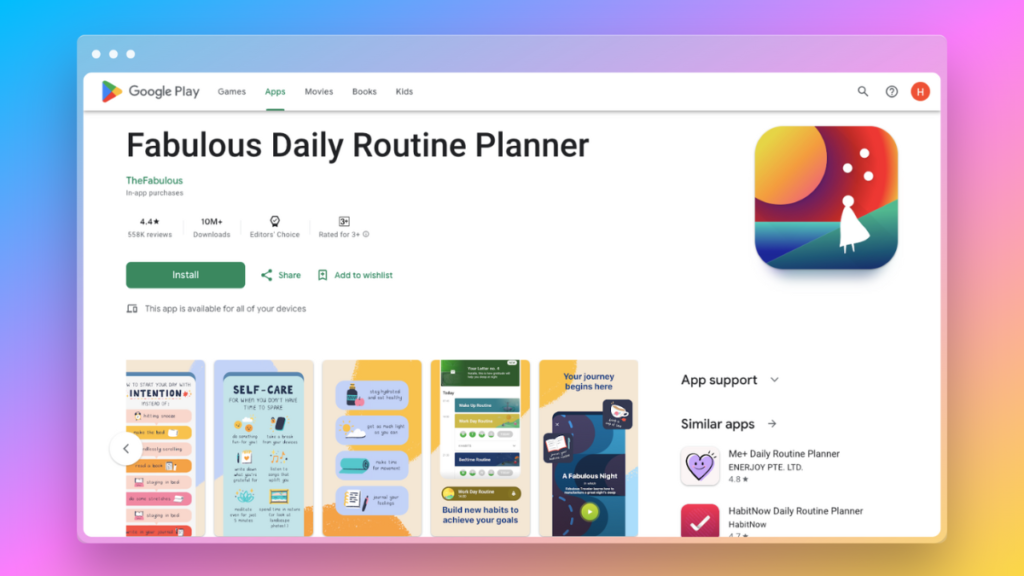
In the palm of every hand lies the potential to access, engage, and be entertained, all thanks to mobile apps.
Whether it’s a game that becomes a global sensation, a fitness tracker that motivates daily exercise, or a meditation app that guides users toward mindfulness, the impact of mobile apps on our daily lives is undeniable.
If you’ve ever envisioned an app that could make life easier, more enjoyable, or more connected, there’s never been a better time to bring that vision to life.
Developing a mobile app is an adventure in problem-solving and creativity, blending user interface design with functionality to create seamless digital experiences.
It’s about understanding what users need, sometimes even before they know they need it, and delivering that in a package that’s both intuitive and impactful.
Where to Sell Your Mobile Apps?
- Apple App Store: Apple App Store is the premier platform for iOS apps, offering developers a vast audience of iPhone and iPad users looking for the next app to download.
- Google Play Store: Google Play Store is the go-to for Android apps, reaching billions of users worldwide, hungry for new and innovative apps to enhance their digital lifestyle.
- Amazon Appstore: A niche but growing platform for reaching Amazon device users, Amazon Appstore offers an alternative avenue for app distribution.
How Much Should You Charge For Mobile Apps?
The monetization strategy for your mobile app can take various forms, each suited to the type of app you’ve developed and the audience you aim to capture:
- Free with In-App Purchases: Perfect for games and utility apps where users can download for free but pay for additional features, levels, or enhancements.
- Paid Apps: Charging upfront for your app, typically ranging from $0.99 to $9.99, can be effective for niche apps that offer unique value.
- Subscription Models: $1 to $10 per month for apps that provide ongoing content or services, like fitness plans, language learning, or productivity tools.
Imagine launching a gardening app that offers personalized plant care schedules. A free version might include basic care tips, while a premium subscription provides detailed guides, pest control advice, and direct Q&A with gardening experts for $4.99 per month.
When pricing your app, consider the balance between attracting users and generating revenue.
Offering a free version can significantly increase downloads, while various monetization strategies within the app can cater to different user preferences and willingness to pay.
What Are Digital Products?
Digital products are like the invisible magic of the online world, items you can’t hold but can definitely use, learn from, or enjoy. They range from ebooks that fill your mind with new stories and knowledge to software and apps that make life easier, to online courses that transform you into an expert in your field.
Unlike physical goods, digital products are created once and sold infinitely without ever running out of stock. They’re all about sharing skills, creativity, and innovation in a format that’s accessible anywhere, anytime.
Whether it’s a piece of music, a piece of art, or a life-changing app, digital products are the treasures of the internet, waiting to be discovered.
If you’re a freelancer looking to make $10k per month, you must check out these best freelancing skills that are in-demand.
Why Sell Digital Products Versus Physical Goods?
Selling digital products is like having a magic shop where your shelves never empty and the world is your market.
Here’s why you might want to jump into selling digital over physical goods:
- No Inventory Woes: Say goodbye to boxes and warehouses! Digital products live in the cloud, which means you can sell the same item endlessly without ever worrying about restocking.
- Open 24/7: Your digital shop is always open, allowing customers from around the globe to make purchases whether you’re awake or asleep. It’s like having a tireless salesperson who works round the clock.
- Higher Profit Margins: Without the costs of materials, manufacturing, or shipping, the leap from creation to sale is a short one. Most of what you make is pure profit, putting more money in your pocket.
- Instant Gratification: In an age of next-day deliveries still not being fast enough, digital products are instantly available to your customers. It’s the ultimate convenience for both you and your buyers.
- Eco-friendly: With no physical production or shipping, digital products are greener. You’re saving trees and reducing carbon footprints, making Mother Earth a bit happier with each sale.
Selling digital products isn’t just smart business; it’s a seamless blend of efficiency, profitability, and global reach, all while being kind to the planet.
Where to Sell Digital Products?
Diving into the digital market can feel like exploring a vast treasure map, and knowing the best places to set up shop is key to your success.
Here’s where you can start selling your digital creations:
- Etsy: Think of Etsy as a bustling marketplace where creative goods meet eager buyers. It’s perfect for artists, designers, and anyone with a crafty side looking to sell unique digital products like printables, graphics, and patterns.
- Gumroad: Gumroad is like your cool, laid-back shop where you can sell anything from ebooks to music, software, and courses. It’s super user-friendly, making it easy for creators to get their digital products out there with minimal fuss.
- Shopify: Imagine setting up your very own store in a prime location. Shopify lets you do just that in the digital world. It’s great for entrepreneurs who want full control over their online store and the ability to sell various digital products.
- Amazon Kindle Direct Publishing (KDP): For the writers and authors among you, KDP is like having a direct line to the world’s largest bookstore. Publish your ebooks here, and you can reach millions of readers worldwide.
- Udemy: If teaching is your thing, Udemy acts as a vast classroom where you can share your knowledge through online courses. It’s a fantastic platform for educators in all fields, from tech to art.
Choosing the right platform is like picking the perfect spot for your treasure chest. Each has its unique charm, so consider what you’re selling and where your audience likes to hang out.
Happy digital treasure hunting!
Wrapping It Up
Now that we’ve navigated the thrilling world of digital products together, let’s circle back and highlight the key takeaways from our journey:
- Digital products offer a unique opportunity to share your creativity, knowledge, and skills with a global audience, without the logistical hurdles of physical goods.
- From ebooks and online courses to software and subscription services, the variety of digital products means there’s a niche for every creator.
- Platforms like Etsy, Gumroad, Shopify, and Udemy serve as bustling marketplaces where you can connect with eager buyers and build your digital empire.
- Pricing your digital products requires a balance between valuing your effort and understanding what your audience is willing to invest.
- Embracing the digital product space not only boosts your earning potential but also allows you to impact lives and industries worldwide.
As you venture into selling digital products, remember that your unique ideas and creations have the power to inform, entertain, and inspire.
Stay tuned to Penchise for more insights and guidance on making your digital dreams a reality.
Whether you’re refining your current offerings or exploring new digital horizons, we’re here to support your journey every step of the way.
FAQs
1. What are the best digital products to sell 2024?
In 2024, the best digital products to sell online include online courses tailored to niche expertise, subscription-based software services addressing emerging needs, digital art, and NFTs capitalizing on creative trends, and immersive virtual event experiences. These products cater to evolving consumer demands and offer unique value propositions in the digital marketplace.
2. Do digital products make money?
Yes, digital products have immense profit potential. With minimal production costs and virtually unlimited scalability, they offer lucrative opportunities for creators and entrepreneurs.
By tapping into global markets and meeting specific consumer needs, digital products to sell in India can generate significant revenue streams over time.
3. What is the biggest selling product?
Currently, online courses stand as one of the biggest-selling digital products. The continual pursuit of knowledge and skill enhancement fuels their demand.
Additionally, the flexibility of accessing educational content online appeals to a wide audience, making online courses a lucrative option for creators and educators alike in today’s digital landscape.
4. Which niche is best for digital products?
The best niche for digital products depends on factors like audience demand, expertise, and market trends. Niche areas such as personal development, technology, and creative industries often yield high returns due to their evergreen appeal and loyal customer base.
5. What is the future of digital selling?
The future of digital selling lies in personalized experiences and advanced technologies. AI-driven recommendations and immersive VR/AR platforms will enhance customer engagement.
Moreover, decentralized platforms and blockchain technology will offer greater transparency and security. Subscription models and microtransactions will dominate, providing continuous revenue streams for creators while fostering long-term customer relationships in an increasingly digital economy.
6. What are some examples of digital products?
Examples of digital products encompass a diverse range, including online courses tailored to specific skills or knowledge areas, software applications designed for productivity or creative pursuits, digital art and NFTs, e-books covering various topics, mobile apps providing solutions or entertainment, and subscription-based services offering access to exclusive content or tools.
7. How do you create a digital product?
To create a digital product, begin by identifying a niche market or problem to solve. Research audience needs and preferences thoroughly. Develop a unique concept and create high-quality content or software.
Design an intuitive user experience and test the product extensively. Finally, establish effective distribution channels and marketing strategies to reach your target audience and generate sales.
8. What digital products are in demand?
Best digital products to sell on Amazon in high demand include online courses addressing niche skills, productivity tools catering to remote work needs, subscription-based software services offering convenience and efficiency, digital art, and NFTs capitalizing on the trend of digital ownership and virtual event experiences providing immersive entertainment and networking opportunities, reflecting evolving consumer preferences and lifestyle changes.
9. What kind of digital products sell best?
Digital products that sell best typically offer tangible value or solve specific problems for consumers. Examples include online courses providing practical skills or knowledge, productivity tools streamlining tasks and workflows, software solutions addressing common pain points, and digital art or media catering to niche interests or aesthetic preferences. Identifying and meeting the needs of target audiences is key to maximizing sales potential.



